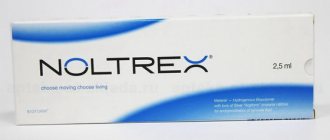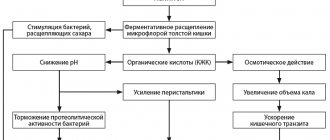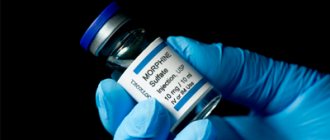Write a review
Reviews: 0
Manufacturers: Nantong Jinghua Pharmaceutical Co. (China)
Active ingredients
- Primidon
Disease class
- Localized (focal) (partial) idiopathic epilepsy and epileptic syndromes with seizures with focal onset
- Generalized idiopathic epilepsy and epileptic syndromes
Clinical and pharmacological group
- Not indicated. See instructions
Pharmacological action
- Hypnotic
- Anticonvulsant
Pharmacological group
- Antiepileptic drugs
Pharmacodynamics and pharmacokinetics
Pharmacodynamics
A drug with a pronounced anticonvulsant effect is classified as a barbiturate. Its chemical structure is similar to phenobarbital . The pharmacological effect is due to a decrease in the excitability of neurons, mainly in the epileptogenic focus. At the same time, Primidon does not have a depressant or pronounced hypnotic effect the central nervous system
Pharmacokinetics
Primidone is absorbed almost completely from the gastrointestinal tract Cmax is reached on average after 2.5-3 hours. The connection with blood proteins is insignificant, about 20%. It has a high level of bioavailability - about 90–100%. It is biotransformed in the liver to 2 metabolites - phenobarbital and phenylethylmalonamide , which have pronounced antiepileptic activity. They are excreted in the urine, both as primidone and as metabolites. The anticonvulsant effect of the drug is manifested when there is a concentration in the blood of at least 12 mcg/ml. For other manifestations of epilepsy (polymorphic seizures, non-convulsive form, myoclonic seizures ) the drug is poorly effective.
Substance-powder Primidone (Primidone)
Instructions for medical use of the drug
Description of pharmacological action
Anticonvulsant, classified as a barbiturate. Causes a mild hypnotic effect.
Indications for use
Epilepsy of various origins, grand mal seizures. Focal, myoclonic, akinetic seizures (less effective).
Release form
powder substance; two-layer polyethylene bag (bag) 5 kg cardboard box (box) 1; powder substance; two-layer polyethylene bag (bag) 10 kg cardboard box (box) 1; powder substance; two-layer polyethylene bag (bag) 15 kg cardboard box (box) 1; powder substance; two-layer polyethylene bag (bag) 20 kg cardboard box (box) 1; powder substance; two-layer polyethylene bag (bag) 25 kg cardboard box (box) 1; powder substance; two-layer polyethylene bag (pouch) 30 kg cardboard box (box) 1; powder substance; two-layer polyethylene bag (bag) 40 kg cardboard box (box) 1; powder substance; two-layer polyethylene bag (bag) 50 kg cardboard box (box) 1;
Pharmacodynamics
Reduces the excitability of neurons in the epileptogenic focus.
Pharmacokinetics
Quickly and almost completely absorbed from the gastrointestinal tract, Cmax is achieved after 3 hours. Bioavailability is 90–100%. In the blood it is slightly bound to proteins (20%). Volume of distribution - 0.64–0.86 l/kg. T1/2 for plasma is 7–14 hours. In the liver, it is partially converted into phenobarbital (15–25%) and phenylethylmalonamide (FEMA) - both metabolites have antiepileptic activity. Excreted by the kidneys in the form of primidone (64%), phenobarbital (7%) and FEMA (5%). A therapeutic concentration of 12 mcg/ml should be maintained in the blood, thereby reducing grand mal seizures. For other manifestations of epilepsy (non-convulsive form, polymorphic seizures, etc.), the effect is not always achieved and complex treatment is required.
Use during pregnancy
Contraindicated.
Contraindications for use
Hypersensitivity (including to barbiturates), hepatic and renal failure, anemia, leukopenia, pregnancy, breastfeeding.
Side effects
Drowsiness, dizziness, headache, apathy, anxiety, nausea, vomiting, anemia, leukopenia, lymphocytosis, allergic reactions. Rarely - nystagmus, ataxia, lupus syndrome, arthralgia, psychotic reactions; extremely rarely - megaloblastic anemia. With long-term use - drug dependence.
Directions for use and doses
Inside, after eating. Treatment begins with a dose of 125 mg once, then every 3 days the daily dose is increased by 250 mg for adults and by 125 mg for children (up to 9 years) until the desired effect is achieved. The maximum daily dose for adults is 1.5 g, for children - 1 g (in 2 doses).
Overdose
Not described.
Interactions with other drugs
Strengthens (mutually) the effect of carbamazepine, diphenine and other anticonvulsants. When used simultaneously with acetazolamide, osteomalacia, rickets, and a decrease in the effectiveness of primidone are possible. There are reports of increases, decreases and no changes in the concentration of primidone in the blood plasma when used simultaneously with valproic acid. When used simultaneously with clonazepam, the concentration of primidone in the blood plasma increases; with phenobarbital - it is possible to increase the concentration of phenobarbital in the blood plasma.
Precautions for use
Can be used in complex anticonvulsant therapy. Cancellation and replacement are carried out gradually. Reduces reaction when driving a car or operating machinery. If megaloblastic anemia develops, discontinue use and begin treatment with folic acid and/or vitamin B12.
Special instructions for use
Cancellation of therapy and replacement of primidone is carried out gradually. Use with caution in elderly and debilitated patients. With prolonged use, drug dependence may develop. If megaloblastic anemia develops, primidone should be discontinued and treatment with folic acid and/or vitamin B12 should be initiated. Use with caution in children. Effect on the ability to drive vehicles and operate machinery Primidone causes a decrease in the speed of psychomotor reactions, therefore, during the treatment period, driving a car, working with machinery and other potentially hazardous activities should be avoided.
Storage conditions
List B: In a dry place, protected from light, at a temperature not exceeding 25 °C.
Best before date
36 months
Side effects
Allergic reactions , anxiety, headache , drowsiness , dizziness , nausea, vomiting, apathy , anemia , lymphocytosis , leukopenia . Rarely - “lupus” syndrome , nystagmus , arthralgia , psychotic reactions. With long-term use of the drug, the risk of drug dependence increases.
Interaction
When taking the drug together with other anticonvulsants, their effect is mutually enhanced. Primidone enhances the effect of methotrexate , hypnotics, cyclophosphamide , sulfonylurea and accelerates the biotransformation of medications, derivatives of estrogen contraceptives, coumarin , doxycycline , griseofulvin . When taken together with rifampicin , phenobarbital and carbamazepine , as well as with alcohol abuse, the effectiveness of primidone and its metabolism is accelerated.
Description of the drug VALPROAT
With the simultaneous use of neuroleptics, antidepressants, MAO inhibitors, benzodiazepine derivatives, ethanol, the inhibitory effect on the central nervous system increases.
With the simultaneous use of drugs that have a hepatotoxic effect, the hepatotoxic effect may be enhanced.
With simultaneous use, the effects of antiplatelet agents (including acetylsalicylic acid) and anticoagulants are enhanced.
With simultaneous use, the concentration of zidovudine in the blood plasma increases, which leads to increased toxicity.
When used simultaneously with carbamazepine, the concentration of valproic acid in the blood plasma decreases due to an increase in the rate of its metabolism due to the induction of microsomal liver enzymes under the influence of carbamazepine. Valproic acid potentiates the toxic effect of carbamazepine.
With simultaneous use, the metabolism of lamotrigine slows down and its T1/2 increases.
When used simultaneously with mefloquine, the metabolism of valproic acid in the blood plasma increases and the risk of developing seizures increases.
When used simultaneously with meropenem, a decrease in the concentration of valproic acid in the blood plasma is possible; with primidone - increased concentration of primidone in the blood plasma; with salicylates - it is possible to enhance the effects of valproic acid due to its displacement by salicylates from its connection with blood plasma proteins.
When used simultaneously with felbamate, the concentration of valproic acid in the blood plasma increases, which is accompanied by manifestations of toxic effects (nausea, drowsiness, headache, decreased platelet count, cognitive impairment).
When used simultaneously with phenytoin during the first few weeks, the total concentration of phenytoin in the blood plasma may decrease due to its displacement from plasma protein binding sites by sodium valproate, induction of microsomal liver enzymes and acceleration of phenytoin metabolism. Next, the metabolism of phenytoin is inhibited by valproate and, as a result, the concentration of phenytoin in the blood plasma increases. Phenytoin reduces plasma concentrations of valproate, probably by increasing its metabolism in the liver. It is believed that phenytoin, as an inducer of liver enzymes, may also increase the formation of a minor, but hepatotoxic, metabolite of valproic acid.
With simultaneous use, valproic acid displaces phenobarbital from binding to plasma proteins, resulting in an increase in its concentration in the blood plasma. Phenobarbital increases the rate of metabolism of valproic acid, which leads to a decrease in its concentration in the blood plasma.
There are reports of increased effects of fluvoxamine and fluoxetine when used simultaneously with valproic acid. When used concomitantly with fluoxetine, some patients experienced an increase or decrease in the concentration of valproic acid in the blood plasma.
With the simultaneous use of cimetidine and erythromycin, it is possible to increase the concentration of valproic acid in plasma due to a decrease in its metabolism in the liver.
Reviews of Primidon
Reviews of the drug among doctors and patients are positive. Many patients note its good effectiveness for essential tremor . Primidone for tremor is prescribed in significantly lower doses than for the treatment of convulsive conditions. As a rule, the initial dosage is 25 mg at night and then increased to 50 mg.
Taking higher doses is not recommended, since increasing the dose does not lead to further improvement in the condition. Patients in the early stages of treatment in some cases complain of drowsiness .
Similar drugs:
- Neurotropin (neurotrophin) Solution for injection
- Magnesium sulfate Powder for oral suspension
- Magnesium sulfate Substance-powder
- Celandine grass (Chelidonii majoris herba) Vegetable raw materials
- Xanax Oral tablets
- Rivotril Oral tablets
- Neurox Solution for intravenous and intramuscular administration
- Tebantin Capsule
- Phenazepam Solution for intravenous and intramuscular administration
- Benzonal Oral tablets
** The Drug Directory is intended for informational purposes only. For more complete information, please refer to the manufacturer's instructions. Do not self-medicate; Before starting to use the drug Primidone, you should consult a doctor. EUROLAB is not responsible for the consequences caused by the use of information posted on the portal. Any information on the site does not replace medical advice and cannot serve as a guarantee of the positive effect of the drug.
Are you interested in the drug Primidone? Do you want to know more detailed information or do you need a doctor's examination? Or do you need an inspection? You can make an appointment with a doctor - the Euro lab is always at your service! The best doctors will examine you, advise you, provide the necessary assistance and make a diagnosis. You can also call a doctor at home . Euro lab clinic is open for you around the clock.
** Attention! The information presented in this medication guide is intended for medical professionals and should not be used as a basis for self-medication. The description of the drug Primidon is provided for informational purposes and is not intended for prescribing treatment without the participation of a doctor. Patients need to consult a specialist!
If you are interested in any other drugs and medications, their descriptions and instructions for use, information about the composition and form of release, indications for use and side effects, methods of use, prices and reviews of drugs, or you have any other questions and suggestions - write to us, we will definitely try to help you.


